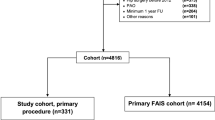Abstract
Purpose
To our knowledge, there is no report in the orthopaedic literature that correlates the duration of hip pain with the results of hip arthroscopic surgery. The aim of this study was to compare the modified Harris Hip Score (mHHS) with patient satisfaction in a prospective study over a two year period.
Methods
We present a prospective single-surgeon series of 525 consecutive patients undergoing hip arthroscopy for a labral tear, femoroacetabular impingement (FAI), or a chondral lesion. Modified HHS was recorded for all patients at the time of surgery and at six weeks, six months and one, two and three years after hip arthroscopy. At the time of surgery, patients were divided into three groups based on duration of preoperative symptoms: group A, under 6 months; group B, six months to three years; group C, over three years.
Results
Mean age was 39 years. There were significantly better outcomes for patients who underwent surgery within six months of symptom onset compared with those who waited longer. Patients who had symptoms for over 3 years by the time of surgery had a significantly poorer result than those with a shorter symptom duration and a higher chance of requiring revision surgery.
Conclusions
We recommend that patients with a diagnosis of labral tear, FAI or a chondral lesion should undergo hip arthroscopic surgery within six months of symptom onset. Patients with persistent symptoms for over three years should be made aware of the poorer outcome after hip arthroscopy.

Similar content being viewed by others
References
Bedi A, Chen N, Robertson W, Kelly BT (2008) The management of labral tears and femoroacetabular impingement of the hip in the young, active patient. Arthroscopy 24:1135–45
Kennedy J, Jackson MP, O’Kelly P, Moran R (2010) Timing of reconstruction of the anterior cruciate ligament in athletes and the incidence of secondary pathology within the knee. J Bone Joint Surg Br 92:362–6
Tannast M, Siebenrock KA, Anderson SE (2007) Femoroacetabular impingement: radiographic diagnosis–what the radiologist should know. Am J Roentgenol 188:1540–52
Tonnis D (1987) Congenital dysplasia and dislocation of the hip in children and adults. Springer, New York, pp 113–30
Byrd JW, Jones KS (2000) Prospective analysis of hip arthroscopy with 2-year follow-up. Arthroscopy 16:578–587
Simpson J, Sadri H, Villar R (2010) Hip arthroscopy technique and complications. Orthop Traumatol Surg Res 96:S68–76
Outerbridge R (1961) The etiology of chondromalacia patellae. J Bone Joint Surg Br 43B:752–7
Crawford JR, Villar RN (2005) Current concepts in the management of femoroacetabular impingement. J Bone Joint Surg Br 87:1459–62
Botser IB, Smith TW Jr, Nasser R, Domb BG (2011) Open surgical dislocation versus arthroscopy for femoroacetabular impingement: a comparison of clinical outcomes. Arthroscopy 27:270–8
Griffiths EJ, Khanduja V (2012) Hip arthroscopy: evolution, current practice and future developments. Int Orthop 36:1115–21
Imam S, Khanduja V (2011) Current concepts in the diagnosis and management of femoroacetabular impingement. Int Orthop 35:1427–35
Ahlén M, Lidén M (2011) A comparison of the clinical outcome after anterior cruciate ligament reconstruction using a hamstring tendon autograft with special emphasis on the timing of the reconstruction. Knee Surg Sports Traumatol Arthrosc 19:488–94
Khan KM (2009) Hip labral tears, economics in sports medicine and guidelines for NSAID use. Br J Sports Med 43:547
Streich NA, Gotterbarm T, Barié A, Schmitt H (2009) Prognostic value of chondral defects on the outcome after arthroscopic treatment of acetabular labral tears. Knee Surg Sports Traumatol Arthrosc 17:1257–63
Lewis CL, Sahrmann SA (2006) Acetabular labral tears. Phys Ther 86:110–121
Hickman JM, Peters CL (2001) Hip pain in the young adult: diagnosis and treatment of disorders of the acetabular labrum and acetabular dysplasia. Am J Orthop (Belle Mead NJ) 30:459–67
Souza BG, Dani WS, Honda EK, Ricioli W Jr, Guimarães RP, Ono NK, Polesello GC (2010) Do complications in hip arthroscopy change with experience? Arthroscopy 26:1053–7
Author information
Authors and Affiliations
Corresponding author
Rights and permissions
About this article
Cite this article
Aprato, A., Jayasekera, N. & Villar, R. Timing in hip arthroscopy: does surgical timing change clinical results?. International Orthopaedics (SICOT) 36, 2231–2234 (2012). https://doi.org/10.1007/s00264-012-1655-x
Received:
Accepted:
Published:
Issue Date:
DOI: https://doi.org/10.1007/s00264-012-1655-x



